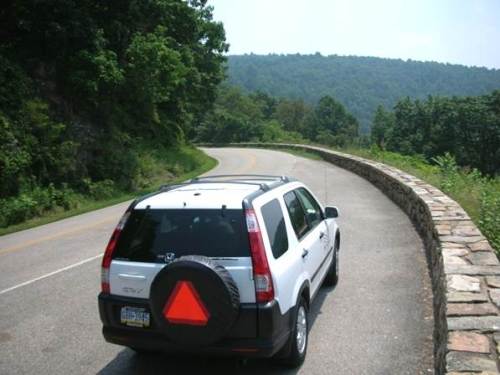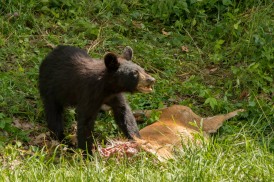
Our survey vehicle on Skyline Drive in the Shenandoah National Park during our initial survey in the summer of 2005
By Keith L. Bildstein, Ph.D.
Sarkis Acopian Director of Conservation Science
Hawk Mountain Sanctuary
20 July 2016
I realize that I am running a risk with this column in talking about raptor monitoring. Indeed, when I begin to talk about monitoring, my audience often begins to doze off. If I continue to talk long enough, some may even fall asleep. Nevertheless, monitoring not only is a useful tool in raptor conservation; it is an essential tool. When we in raptor conservation fail to monitor populations of birds of prey we often pay a steep and, in some instances, an irreversible cost.
Consider the current plight of the Indian Long-billed and Asian White-rumped Vultures, two species that 40 years ago ranked as the world’s most abundant large raptors. Both species were then common and widespread throughout southeastern Asia. When populations of both species crashed by more than 95% in Bharatpur, India in less than two decades in the late 1900s, the problem was thought to be pesticides. But when similar reports were received for other populations elsewhere in these species wide ranges, a lack of earlier population monitoring made it difficult initially to ascertain the actual magnitude of the declines.
Two vultures that had once been so common that no one thought to monitor the sizes of their populations were now so uncommon that some conservationists were suggesting that they were in the “fast-lane” to extinction. Half of a very large number is still a very large number, and by the time people were paying attention to these formerly species few knew what their once very large numbers had been.
Eventually conservationists learned the problem was an FDA approved drug, diclofenac, then in use on livestock. Diclofenac, a non-steroidal anti-inflammatory substitute for aspirin that, while non-toxic to humans, turned out to be highly toxic to vultures in the genus Gyps. But without proper population monitoring, we had reached a point where expensive captive breeding was necessary to reverse the trends. Had we been monitoring these populations earlier, such extreme measures would not have been necessary.
Which brings me to my point. Monitoring populations of raptors—even common and abundant species—is a critical component of practical and effective raptor conservation. This is why Hawk Mountain decided to begin doing so with two species of common and widespread New World vultures in 2005. As of late 2015, the Sanctuary has surveyed Black, Turkey, and other vultures in 23 locations throughout the Americas: from central western Canada in northcentral North America all the way south to Tierra del Fuego in southern South America and the Falkland islands in the South Atlantic.
Our surveys include both winter and summer counts totaling more than 24,000 miles of road counts across 14 United States, 4 Canadian provinces, and 6 central and South American countries. Surveys are conducted by a driver and one official observer along secondary routes at 30 to 40 miles an hour on rain-less and fog-less days. Counts begin at nine in the morning and end at four in the afternoon after and before most of the birds have roosted for the evening. In addition to Black and Turkey vultures, all other scavenging birds of prey are counted as well, including all other vultures, condors, and caracaras.
When we began the counts in 2005, the plan was to survey both Turkey Vultures and Black Vultures in representative areas across much of their geographic ranges and to redo the surveys once a decade in both winter and summer, so that populations of both migratory and resident populations of these common scavengers could be monitored routinely. Declines in numbers could be assessed in a timely fashion, and conservation action taken as necessary, before populations had declined catastrophically.

An unexpected “non-vulture” scavenger feasting on a road-killed deer along Skyline Drive during our second round survey in the summer of 2016.
Round two of our surveys began in early July 2016 when three Summer Field Experience Interns and I redid two day-long road counts in northern Virginia that were originally undertaken in the summer of 2005. One of the routes was a mountainous 195-kilometer meander along Skyline Drive in the Park Service’s Shenandoah National Park and the northern-most section of the Blue Ridge Parkway. The other was a 211-km route that followed the eastern shoulder of the upper Shenandoah Valley. The numbers of vultures sighted were encouraging. During two days of field work this summer, we counted a total of 253 Tukey Vultures and 14 Black Vultures, versus 124 TVs and 9 BVs seen on the summer 2005 counts.
Although this initial field effort was a modest one, we will ramp-up counts this winter to include 6 routes totaling 963 kilometers in western and central Panama, along with the two winter counts in northern Virgina. Over the next five years, we plan to re-conduct all of our surveys from west-central Canada south to Tierra del Fuego. We hope to find that all populations previously surveyed are stable of increasing. However, if they are not, we plan to put conservation actions into play that will determine the cause or courses for the declines and begin work to reverse them.
Vulture perform important ecological services in the ecosystems they inhabit, not the least of which include nutrient recycling and reducing the likely spread of diseases including botulism, anthrax, and rabies. Protecting their populations is a critical aspect of Hawk Mountain’s mission, and we plan to stay on top of this. Our next surveys in Virginia are scheduled for December 2016. We plan to redo our winter surveys in Panama in January 2017. Once we have conducted them I will be in touch.
Between then and now let me know if you have any questions on this monitoring effort and how you can support the Sanctuary financially in carrying out this crucial part of our mission. Feel free to email me at Bildstein@hawkmtn.org or call me at 570 943 3411 ext. 108.